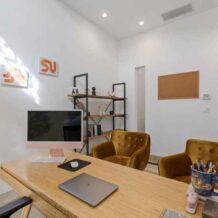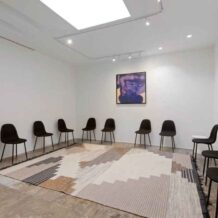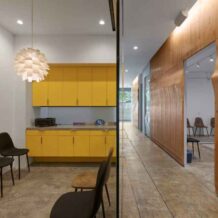Rehabilitation centers play a crucial role in helping individuals heal from addiction, accidents, and long-term illnesses. These centers offer a wide range of services, including physical, occupational, speech, and psychological therapy, to help patients regain their strength, skills, and confidence. Additionally, rehabilitation centers contribute to public health by reducing the need for short-term medical care and cutting healthcare costs. Holistic approaches, such as yoga, meditation, and acupuncture, are becoming increasingly important in rehabilitation programs. The choice between inpatient and outpatient rehabilitation depends on the individual's needs and the severity of their condition. Specialty therapies, such as pediatric physical therapy and aquatic therapy, provide focused help for specific issues. Innovative therapy techniques, like aquatic therapy and vestibular therapy, are being implemented in Santa Monica rehab centers. Stroke rehabilitation, led by physiatrists, focuses on improving motor skills, balance, coordination, speech, and mental processes through various therapies and techniques.
Transforming Lives at Santa Monica Treatment Centers
7 min to read
Santa Monica treatment clinics are vital to community health, offering hope and regeneration to individuals struggling.
Santa Monica has a strong network of rehabilitation institutions that provide comprehensive recovery and transformative treatment. These facilities aim to change lives via a wide range of medical, emotional, and psychological therapies. These institutes satisfy the different needs of the community with innovative physical rehabilitation techniques and holistic methods, highlighting incredible transformation stories that inspire and encourage sustained wellbeing. They improve Santa Monica's well-being as vital pillars of the healthcare system, making it a model for community health initiatives.

The Role of Rehabilitation Centers
Rehabilitation centers are crucial for people who are healing from addiction, accidents, or long-term illnesses. These buildings improve the health of the neighborhood and help people heal. Their wide range of rehabilitation services meet the short-term and long-term needs of their patients.
Rehabilitation centers help people get their strength, skills, and confidence back so they can go back to their normal lives. Physical, occupational, speech, and language treatment, as well as psychological help, are all part of rehabilitation programs. Rehab centers offer treatment, therapy, and support groups to help people heal from addiction. These methods fix the mental and physical effects of addiction or pain, which promotes health in all areas.
Public health issues are handled by rehabilitation centers. They help people with long-term illnesses or disabilities reduce the need for short-term medical care. This improves these patients' quality of life and cuts healthcare costs by reducing the number of hospital readmissions and long medical treatments.
Community groups and rehabilitation clinics often work together to provide more help to people in need. By working with businesses, schools, and social services, they offer a health plan that is focused on the community and helps everyone.
Comprehensive Treatment Services
There are different types of rehabilitation services, such as inpatient rehabilitation, outpatient therapy, and specific treatments. Inpatient rehabilitation offers long-term medical and mental health care in a home setting. Flexible outpatient therapy lets people go to classes while still doing their normal things. Some problems can be helped by specialized treatments like aquatic therapy, neurorehabilitation, and speech therapy. All of the patients will get the right care and expert treatment to get better, thanks to this wide range of services.
Holistic treatment is becoming more and more important for rehabilitation programs to work. Standard therapy plans include yoga, meditation, and acupuncture as ways to improve physical, mental, and spiritual health. For unique rehabilitation, a holistic health practitioner guides patients through these steps.
Some of the physical benefits of ancient yoga are better balance, flexibility, and strength. These benefits can help people who are healing from physical problems. Yoga calms the mind and body, which helps people in rehabilitation deal with mental stress.
By encouraging deep relaxation and mental awareness, meditation, another important part of holistic healing, aids rehabilitation. Meditation can help people who are in pain, anxious, or emotionally unstable. Mental clarity and peace can make standard therapy work better by getting people more involved and attentive to it.
In certain parts of the body, skilled holistic health practitioners insert small needles to ease pain and speed up the mending process. Acupuncture is useful in rehabilitation because it can ease pain and help the body heal itself. It will help people who would rather not take drugs to treat their pain.
When it comes to rehabilitation, inpatient rehab centers and outpatient therapy are not the same thing. Figuring out how these choices are different can help you pick the right treatment for your sickness.
For weeks or months, people go to inpatient rehab centers 24 hours a day, seven days a week, for intense home treatment. This is a great place for people with serious illnesses who need daily medical care or who need an organized place to recover from big addictions or surgeries. The controlled environment cuts down on distractions and temptations, which helps people recover.
Outpatient therapy, on the other hand, allows patients to remain at home while going to rehab classes several times per week. This therapy works great for people with light to moderate illnesses or who are leaving hospital care and need professional help. By letting patients keep up with their normal routines, like work or school, outpatient care can greatly improve the success of rehabilitation.
Whether a patient goes to a hospital or an outpatient facility depends on their needs and how bad their situation is. Outpatient therapy is good for people who need less intensive care and can fit their treatment into their daily lives. Inpatient centers, on the other hand, are best for people who need full-time, intense care. Each place has its own benefits, and the best one for each person depends on their needs and situation during rehabilitation.
Specialties in rehabilitation offer focused help for certain issues. Pediatric physical therapy, vestibular rehabilitation, and aquatic therapy stand out because they use different methods and work with different types of patients.
Kids can reach their full physical potential with the help of pediatric physical therapy. Children who are behind in their growth, were born with disabilities, or have injuries that make it hard for them to do daily chores need this therapy. Physical therapists for kids use fun, age-appropriate tasks to keep kids interested and help them move and function better. Young children's motor skills, strength, and balance get better when they start this practice early on, which improves the long-term effects.
Balance problems, dizziness, and problems with the inner ear can all be helped by vestibular rehabilitation. Customized balancing routines and physical methods are used in this type of treatment to improve balance and help people with vertigo. Vestibular rehabilitation helps people get back to doing normal, safe things by getting their vestibular system back to normal or by helping their brain get used to problems with their inner ears.
Flotation, resistance, and hydrostatic pressure are used in pools and other water treatments to help with rehabilitation. Because water makes you float, it's great for people with arthritis, serious pain, and people who have recently had surgery because it eases muscle and joint strain. Treatment in the water improves strength, flexibility, and aerobic fitness without the negative effects that come with exercises on land.
Innovative Therapy Techniques
In Santa Monica, rehab centers are trying out new ways to treat patients. While all of them have benefits for different types of people, aquatic therapy and vestibular therapy stand out because of the way they are used. This includes pediatric physical therapy.
A lot of people in Santa Monica like aquatic therapy, which is also sometimes called aquatic physical therapy. The buoyancy of water is used in this treatment to ease stress on joints, bones, and muscles caused by exercise. People who are recovering from joint replacement surgery, have long-term arthritis, or have spinal problems may find that aquatic treatment changes their lives. Without the stress of going to the gym, water resistance is a natural and effective way to build strength and improve heart health. The hydrostatic pressure of water lowers swelling and improves blood flow, which makes aquatic therapy a full treatment for rehabilitation.
Inner ear diseases often make people lose their balance and feel dizzy. Vestibular treatment can help with these problems. To rebalance the system, centers in Santa Monica use vestibular rehabilitation to develop specialized treatment plans. The brain learns to deal with problems in the inner ear through movements for the head, body, and eyes. The activities slowly improve balance and lessen vertigo and dizziness. People who have trouble with their balance because of an accident or illness need this practice to keep them stable while they do everyday things.
When it makes sense, aquatic and vestibular exercises are used in Santa Monica pediatric physical therapy. Pediatricians make care fun and effective for kids who are behind in their growth, were born with a disorder, or have been hurt. Aquatic therapy gets kids to do things that look fun by putting them in a nice environment. When addressing kids' balance and coordination, vestibular parts are carefully added to make sure the therapy is right for their age and works.
Stroke therapy helps people who have had a stroke get their lives back on track. Physiatrists and other experts in physical health and rehabilitation are essential to this process. They are taught how to make patient-centered rehabilitation plans for people who have had a stroke and are having a lot of different problems.
A physiatrist checks the motor skills, balance, coordination, speaking, and mental powers of people who have had a stroke. They are in charge of interdisciplinary stroke rehabilitation based on this review. Physical, psychological, speech-language, and neuropsychologists are often called in to help the patient get better. During the process, the physiatrist changes treatment plans and talks about new rehabilitation goals.
As part of a physiatrist-led stroke rehab program, people work on their physical strength and balance, go through speech therapy to improve their communication, and do cognitive therapy to improve their mental processes. They also do manual therapy to help them get back into everyday life. Physiatrists use electrical therapy, robotic-assisted treatment, and virtual reality to help patients heal faster and improve neuroplasticity, which is the brain's ability to change its structure by making new nerve connections.
Conclusion
Through holistic healing and in-depth rehabilitation, treatment facilities in Santa Monica enhance people's lives. These places provide a range of treatments that can be tailored to each patient's needs, making care more approachable. The facilities offer a wide range of services to help people get better, from cutting edge physical rehabilitation to more natural approaches like yoga and meditation. Their programs put a lot of stress on community support to make sure that rehabilitation heals the whole person and creates a helpful environment outside of treatment rooms. The effectiveness of therapy and patient rehabilitation are both improved by this community-focused approach. By offering great care and help, these facilities continue to make the Santa Monica area healthier and more lively.
Discussion
Safe, Nurturing, Healing
Tulua Health is More Than a Recovery Center
Safety and support form the cornerstone of recovery at Tulua Health. We offer a nurturing environment that extends beyond treatment. Our facilities boast modern amenities, ensuring privacy, comfort, and a range of supportive programs. Here, every aspect of our sober living homes is designed to provide you with a sanctuary that you can proudly call home.
We Accept Many Health Plans

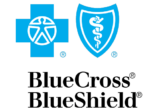

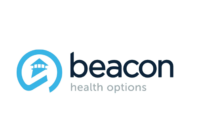
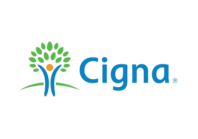
It Starts here
Get a Free Health Coverage Verification
Wellness doesn't just happen. Our team of behavioral health specialists can help find the plan that is right for you. If you're ready for a new start, click below to submit a free health insurance verification request.
